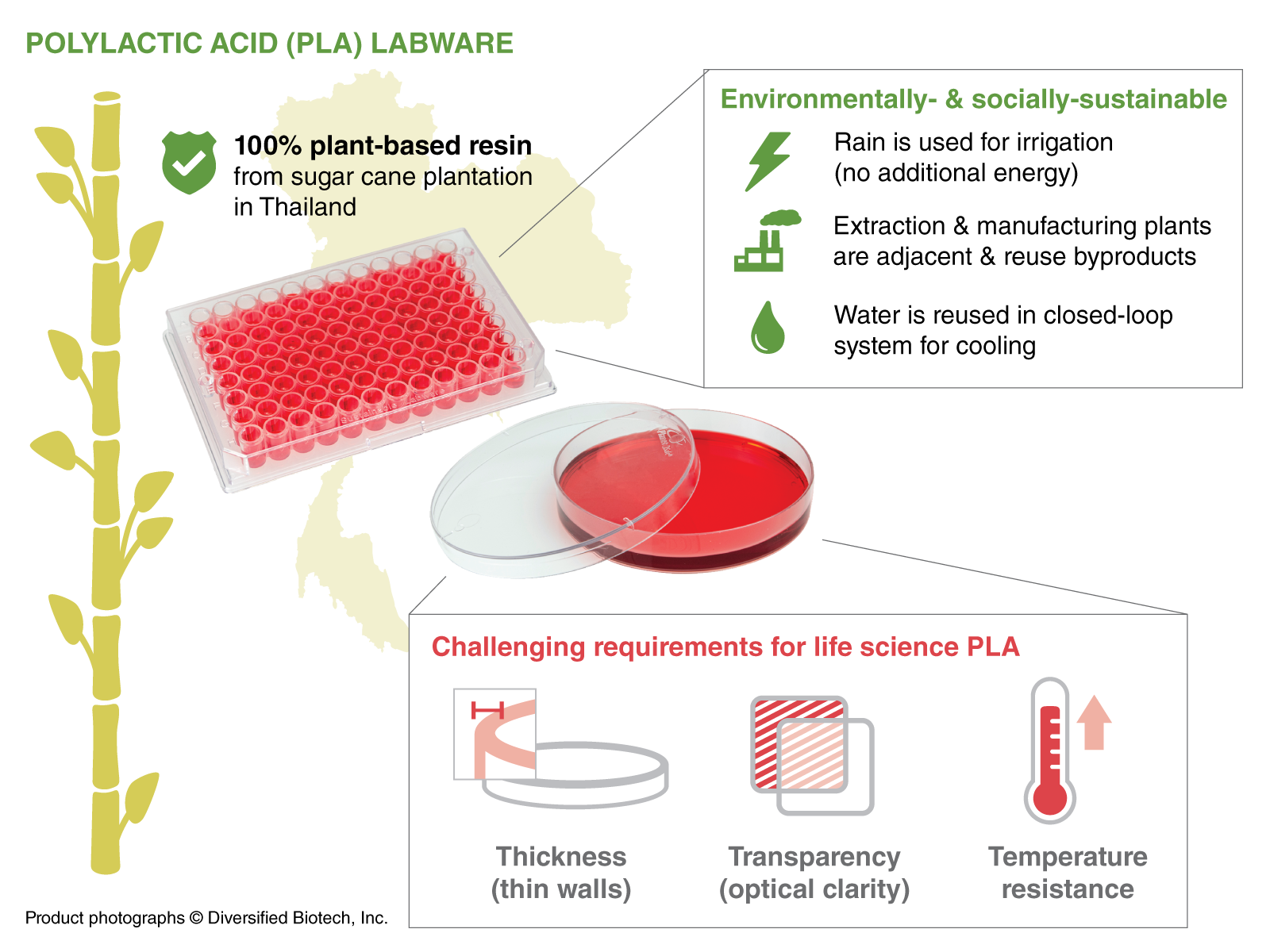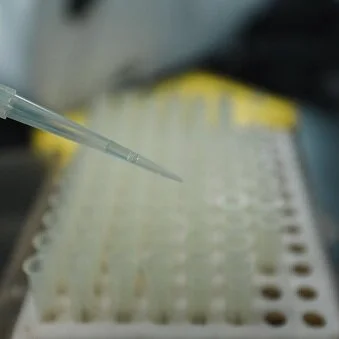It’s always exciting when a maverick hits the mark. The first polylactic acid (PLA) Petri dish product is a one-to-one replacement for labs using fossil fuel-based plastics for tissue culture. The maker, a small privately owned company called Diversified Biotech, Inc., collaborated with researchers from Brandeis University to develop it. Fostering eco-justice with a simple swap sounds good, but could this specialized PLA material even improve cell culture?
Our thanks to Greg Kwak for providing technical insights on this pioneering lab plastic, Planet-Safe®
Q&A with Greg Kwak, Diversified Biotech
1. How did the idea of using PLA as a material for lab plastics come about?
We offered ‘better alternative’ reagent reservoirs in 2007. I had learned about PLA for that project, and at the time it was a newer material that hadn't been commercialized yet. We circled back in 2017 and designed a lab scoop that was made from PLA as well as some weighing dishes.
By then there was wider concern about the impact of fossil fuels and growing concern in the lab about the amount of plastic waste being generated. I spoke with Allison Paradise, who at that time was with My Green Lab. We talked about which lab items posed the biggest environmental concerns. One of the items to surface was Petri dishes. We knew there were a lot of plastic Petri dishes being used and that it would be a fairly simple part to develop, so we started there and created an eco-friendly and economical cell culture dish.
2. PLA has been around for a long time, why do you think it hadn't been used before to manufacture labware?
In terms of requirements for life science PLA poses several challenges, particularly temperature resistance and optical clarity. It's difficult to make a thin walled, optically clear PLA part, especially one that's temperature resistant.
By way of example, most people are familiar with clear plastic drinking cups that are made from PLA and widely used commercially. These cups are fine for cold water, but when hot water is introduced, the material softens or melts. To remedy this issue, talc is typically added but the result is an opaque part. However, for labware like Petri dishes and microplates, where transparency is crucial, an opaque material does not work. The solution was the result of an ingenious process involving electron beam irradiation to bolster the polymer’s temperature resistance without the need for talc or other additives.
Also, it doesn't take long for a Petri dish manufacturer to find out, as we did, if they substitute polystyrene pellets for PLA pellets, it won't go well. Traditional plastics and PLA use injection molding to make parts. But PLA is more “sticky” and therefore more problematic because it doesn’t release cleanly from traditional molds. Thus, it can leave undesirable marks or “fingerprints” on the clear surface. PLA is finicky and requires many additional considerations in terms of tooling, cooling, and mold duration to ensure optically clear, temperature resistant parts. It's just not a straightforward replacement.
One last thing about PLA; Interestingly, in its base form, PLA is more hydrophilic than polystyrene. We discovered this during our development process, and it led to a unique approach that enabled us to greatly enhance this desirable feature. For the curious, this is all spelled out in our patent.
3. Okay, hydrophilicity is an interesting property from a biologist’s perspective. We sometimes take for granted how a substrate material influences cultured cells. So then, what would you say are the unique properties of this PLA that make it work for cell culture?
Our PLA resin is formulated differently to achieve the required clarity and temperature stability. It's very different than the standard PLA resin you would see when making, say PLA utensils. It's formulated to withstand higher temperatures. Beyond that, I would point to the manufacturing methods we developed and the irradiation procedures we employed. We had to figure out the amount of radiation required to create a surface to support cell growth. Adherent cell culture is only possible with polystyrene because the surface is treated to facilitate cell adhesion. To manufacture a polystyrene cell culture dish, its surface must be oxygen plasma treated, or treated with a Poly-L-Lysine coating if you aim to grow cells in reduced or serum-free conditions. The manufacturing process we developed with irradiation took the base level of PLA hydrophilicity and increased it exponentially. This is why Planet-Safe® facilitates cellular growth in the same manner as tissue culture-treated plates. Right now, we are making cell culture dishes and 96-well plates, but additional multiwell plate formats will be available later this year with tissue culture flasks to follow. Also, because considering an alternative material for research can be difficult, we have samples readily available for anyone wanting to try Planet-Safe® in their current application.
4. What type of collaborative work took place during development?
Research and development of the PLA polymer was spearheaded by a longstanding consultant for Diversified Biotech, Dr. Daniel Perlman, Senior Research Scientist Emeritus, Brandeis University. Dr. Perlman's contributions were important in determining the PLA formulation parameters. Once the advantages of culturing cells on a PLA surface were discovered, Dr. Perlman designed tests to measure and illustrate the improved surface. It was his testing and research that ultimately led to a patent. For example, increased hydrophilicity was demonstrated with a water droplet-based test. We also did side-by-side cell growth testing with three common cell lines, HEK293 suspension-adapted cells, HEK293 adherent cells, and COS adherent cells. The resulting cellular morphologies and growth rates were indistinguishable from conventional polystyrene cell culture plates.
5. What is the main way this labware reduces the ecological footprint of a typical researcher?
The greatest value comes from the labware being a 100% plant-based resin, certified by Bon Sucro for environmental and social sustainability “Best Practices” in sugarcane. By using Planet-Safe® you’re not supporting the fossil fuel industry. There are more benefits with disposal we can talk about, but avoiding fossil fuel-based plastic to begin with is the big win.
6. How does the production of this 100% plant-based labware compare ecologically with traditional lab plastics like polystyrene and polyethylene?
The PLA resin we use comes from starch from sugar cane growing at a plantation in Thailand. The producers do not use traditional harvesting methods which involve burning their fields to turn the rest of the plant into smoke and ash, leaving only the sugar cane stalk. In that area of the world, there are no water scarcity issues. Meaning, that the producer doesn’t have to use any energy to run irrigation systems because the natural rain cycles are consistent enough to allow them to grow their crops sustainably. Once the plants are harvested, there's one facility that extracts the starch, and another that creates the PLA, and they're right next to each other. Byproducts get reused in the process. Very close attention is paid to the amount of waste that's generated, its use to make other products, and quantifying the carbon that goes into the actual manufacturing. Even the water that is generated enters a closed-loop system. So it just circles right back around for cooling purposes and processes of that nature. There's no water being dumped out. Bon Sucro, a third-party organization, verifies all of this is happening on a plantation. They also update plantations when improved practices become available. Bon Sucro provides a Chain of Custody certification, so our material is verified. It’s fair to say that the transportation footprint to get the resin to where we manufacture the labware in Oregon represents most of the carbon footprint.
Contrast that with the production of a resin, like, say, polystyrene. There's a tremendous difference in terms of the ecological footprint. There are a lot of nasty things that go into making polystyrene and polyethylene. Of course, they're derived from fossil fuels, but the amount of carbon that goes into that production process is also much greater than the production of PLA. That’s a lot of ecological savings that can be had by a researcher switching to Planet-Safe®.
“There’s a tremendous difference in terms of the ecological footprint. There are a lot of nasty things that go into making polystyrene and polyethylene. Of course, they’re derived from fossil fuels, but the amount of carbon that goes into that production process is also much greater than the production of PLA. That’s a lot of ecological savings that can be had by the researcher by switching to Planet-Safe®”
7. Let’s talk about disposal. What’s the environmental impact if it’s incinerated?
The high-level view is that when Planet-Safe labware is incinerated, it doesn't release anything harmful. So essentially when you incinerate it, nothing harmful comes out. It's funny to say it this way, but the level at which any toxins are not detectable is much lower than polystyrene PET.
8. I'm also curious, if it's decontaminated with bleach solution or autoclaved, could you compost it?
Sometimes we get asked, “What’s the benefit of PLA if I can’t compost it?” I want to emphasize again the massive benefit to the environment that comes from just decreasing demand for fossil fuel-based plastic. If you walked up to anyone on the street and said I have this, it's 100% made from plants, I have this, it's plastic. I'm going to throw both away. Which one is better to throw away? They'll say the plant-based one and they will be right.
Both our cell culture dishes and microplates have passed ASTM D 6400. At 84 days they sufficiently break down and are considered to be commercially compostable.
If you were to autoclave Planet-Safe® to deal with biohazardous material, it's going to melt and deform. Some studies have shown if you autoclave PLA it will compost faster. It stands to reason if you take a biohazardous waste plate or dish and autoclave it and then send it to an industrial compost center, not only will it break down, but it'll do so more quickly.
9. What about microplastics from composting?
There was a study conducted in Spain across five industrial compost facilities (1). They found all sorts of different plastics. 94% of the microplastics that they found were attributed to five of the most common plastics. There was no microplastic debris detected from any bio-based plastics, including PLA. This suggests that our PLA will release no microplastics in industrial composting. Down the line, we will verify that with further research and testing.
10. You’d think end-of-life would be my last question, but I have one more for you, Greg. What was your favorite part of this project?
It's been a great project and has been very fulfilling. I've been challenged along the way by very smart people with tough questions. It’s much like what I tell my kids. You should never be afraid to say, ‘I don’t know’, as long as you add, ‘but I’ll find out.’ As a group, and as a company, the environmental aspect of this project is something we all believe in very deeply.
Reference:
1. Carlos Edo, Francisca Fernández-Piñas, Roberto Rosal. Microplastics identification and quantification in the composted organic fraction of municipal solid waste, Science of the Total Environment, 151902, 2022 doi.org/10.1016/j.scitotenv.2021.151902








